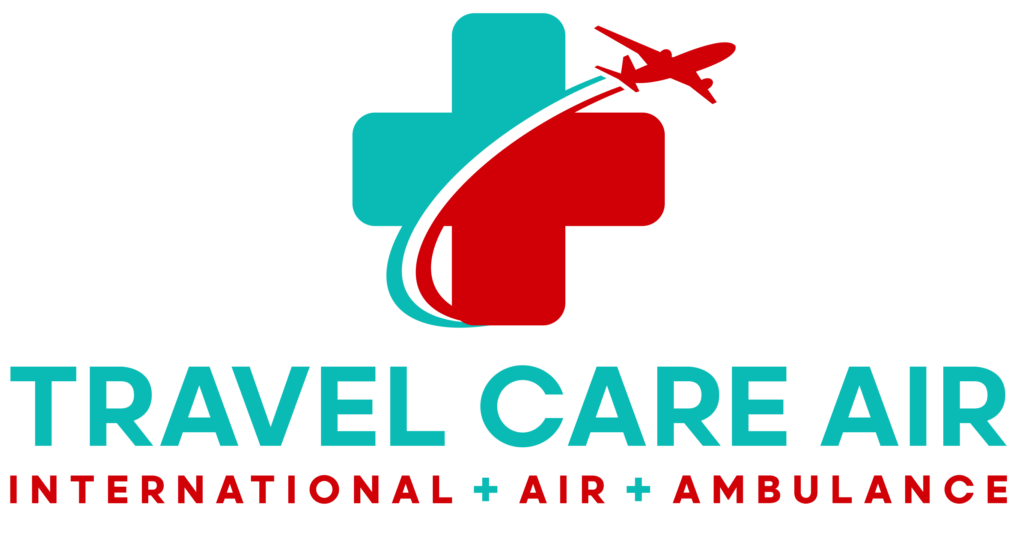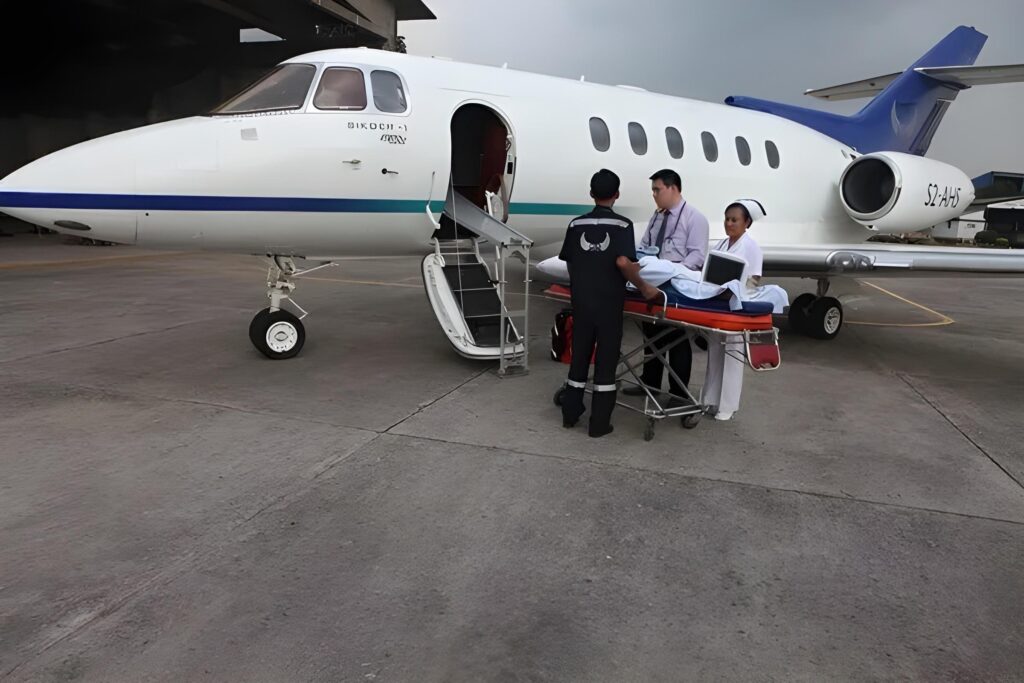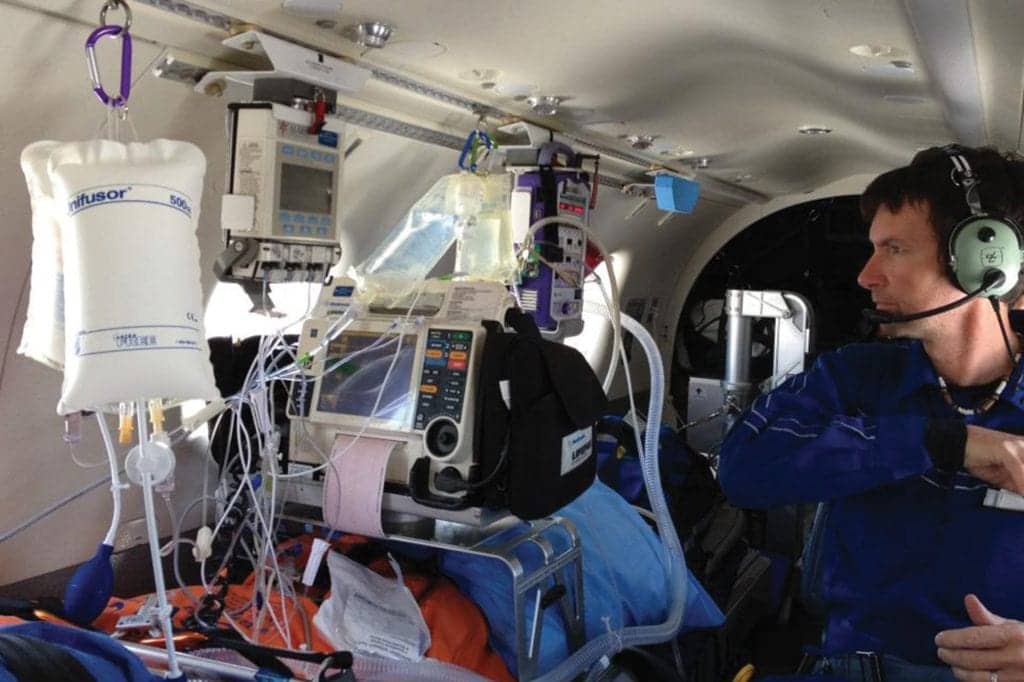You’re on a long-awaited vacation, enjoying a sunny day on the beach when a loved one suddenly collapses from a stroke…or maybe you’re halfway around the world and an e-bike accident leaves you seriously injured. In moments like these, when every second counts, an air ambulance can be the bridge you need between crisis and critical care. Yet one of the first questions most families ask is about air ambulance safety and whether it’s really the safest option for someone who is already in a fragile condition to be flown in an aircraft.
It is completely understandable to have that concern. The idea of being thousands of feet in the air while relying on medical equipment and an unfamiliar crew can feel really scary. But modern air medical transport is specifically designed for these types of high-risk situations. Every safe medical flight operates like a hospital intensive care unit in the sky, and is fully equipped with advanced technology, specialized crews, and some very strict safety protocols that protect the patient from takeoff to landing.
Here’s what you’ll learn:
- How flight crews maintain the highest levels of safety and care during every mission.
- What advanced medical equipment and trained specialists are onboard each flight.
- When and why air transport is the safest option for patients in serious condition.
- How strict medical and flight protocols protect patients throughout the journey.
- Why today’s air ambulances are among the most advanced and secure medical environments anywhere in the world.
How Safe Is Air Medical Transport for Critically Ill Patients?
When people hear the phrase “air ambulance,” they sometimes imagine emergency flights that are taking place under stressful conditions, and that raises an important question about air ambulance safety. Can a patient who is already in critical condition be transported safely by air? The answer is yes. These flights are highly controlled, medically equipped, and staffed by experienced professionals that are trained to handle emergencies at high altitudes.
The air ambulance industry follows some very strict regulations from organizations such as the Federal Aviation Administration (FAA), the Commission on Accreditation of Medical Transport Systems (CAMTS), and the National Transportation Safety Board (NTSB). These high standards govern everything from aircraft maintenance and pilot qualifications to medical crew readiness and infection control. Each flight team includes highly skilled paramedics, flight nurses, and sometimes physicians, all of whom are trained in critical care and advanced life support that is specific to air transport.
Are air ambulances safe? Absolutely. You can rest assured that every mission begins with detailed pre-flight checks to ensure the aircraft, medical gear, and patient setup meet all operational standards. Infection prevention measures, oxygen level monitoring, and real-time communication with the ground hospitals are all standard practice.
Modern aircraft feature dual engines, advanced navigation systems, and redundant power supplies to minimize any risk. In addition, flight crews stay in constant contact with the dispatch centers and destination hospitals, which helps to make sure that coordination stays smooth throughout the journey.
Most importantly, patient safety during air transport is built into every single stage of the process, from the initial stabilization and loading to midair monitoring and hospital handoff. Each air ambulance functions as a flying intensive care unit, where every detail is focused on one goal…delivering the safest possible environment for patients in critical condition.
What Happens During a Medical Flight
Many families wonder exactly how does a medical flight work? Understanding the process can help ease anxiety and show just how coordinated and safe these missions truly are. Every flight follows a series of structured steps that are focused on providing the best possible comfort, care, and air ambulance safety from start to finish.
It all begins at the patient’s bedside. A specialized ground ambulance team arrives to transport the patient to the airport or helipad, and they ensure they remain stable during the entire transfer. Once the aircraft is ready, the medical crew (which is usually made up of a pilot, flight nurse, and paramedic) carefully loads the patient using advanced lifting equipment and secures them on a stretcher that is designed for in-flight care. In more complex cases, respiratory therapists or physicians may also join the team to provide higher levels of support for patients who need it.
Once in the air, the aircraft functions as a mobile intensive care unit. The onboard medical team continuously monitors vital signs, using ventilators, cardiac monitors, defibrillators, infusion pumps, and oxygen systems. Medications are present and are given throughout the flight as needed, ensuring that emergency treatment can be administered instantly if needed.
Throughout the journey, the crew stays in constant communication with hospitals on both ends, sharing updates, transmitting vital data, and preparing the receiving team for immediate handoff once the aircraft lands. This coordination is what ensures seamless continuity of care without a single lapse in medical attention at any stage along the way.
Every detail of this process reinforces air ambulance safety and helps to create a truly safe medical flight environment. From strict equipment checks before takeoff to careful patient monitoring midair, these flights are specifically designed to deliver hospital-level care in one of the most controlled and prepared environments possible.
Common Situations That Require Air Medical Transport
People often ask what kinds of illnesses require an air ambulance, and the answer covers a wide range of different emergencies…some that happen close to home and others that occur thousands of miles away, on the other side of the globe. Air medical transport exists in order to help patients reach the level of care that they need when time, distance, or location makes ground travel unsafe or impossible. Every mission is carefully coordinated to ensure complete air ambulance safety and to make sure that critical patients receive constant, expert care from the moment the wheels leave the tarmac, all the way to touchdown.
One of the most common scenarios that require medical air transport involves serious accidents while traveling. Injuries from e-bikes, mopeds, or scooter crashes are becoming increasingly common in tourist destinations where local hospitals may not have the advanced trauma units that are required to provide the best possible care. In these cases, air transport allows patients to be flown to specialized facilities that can provide this lifesaving treatment. Also, vacationers that are injured abroad after car accidents, hiking falls, or boating incidents may need to depend on international air ambulances to return home to get the proper care that they need.
Cardiac emergencies are another leading reason for medical flights. Patients who suffer heart attacks or strokes often need rapid transfer to a facility that is specially equipped with cardiac catheterization labs or skilled neurosurgical teams. Every minute matters in these situations, and air transport dramatically reduces travel time while also ensuring patient safety during air transport through advanced monitoring and immediate access to medications or defibrillation equipment.
Premature births and neonatal emergencies also require specialized air transport. These flights usually include neonatal incubators and specially trained neonatal nurses or respiratory therapists who can manage the fragile health of newborns while they are in transit. Maternal transfers for high-risk pregnancies are also handled with an equal level of precision, ensuring both mother and baby receive continuous monitoring.
Organ transplant coordination is another important use of air medical transport. These missions involve flying patients that are awaiting transplants or carrying the organs themselves, such as hearts or livers, under some very tightly controlled timing and temperature requirements.
Domestically, air ambulances are also very important for patients that are in rural or remote areas who need to reach larger medical centers. During natural disasters or medical crises abroad, they can act as a lifeline for evacuation to safer, better-equipped hospitals.
Each of these situations demands the highest level of precision, speed, and medical expertise. Through strict air ambulance safety protocols and advanced in-flight technology, patients are kept protected every step of the way…no matter where the emergency begins or how severe the condition may be.
The Lifesaving Equipment Inside the Aircraft
Every detail of an air medical transport aircraft is designed to protect and stabilize patients that are in critical condition. These planes and helicopters operate like flying intensive care units, equipped with technology that mirrors (or often even surpasses) what’s found in many hospitals. This high level of preparation is what helps to ensure both a safe medical flight and the highest standards of air ambulance safety for every single patient that comes onboard.
Each aircraft is stocked with essential medical systems, including ventilators to help with breathing, cardiac monitors to track heart activity, infusion pumps for IV medications, and defibrillators for cardiac emergencies. Oxygen delivery systems, suction units, and advanced monitoring tools give crews the ability to manage difficult cases such as trauma, cardiac arrest, respiratory failure, or premature birth. In many cases, there’s even space for specialized equipment like neonatal incubators or advanced life support modules.
Sterilization and maintenance protocols are as strict as any hospital environment. All medical tools and surfaces are sanitized between missions, and the aircraft undergoes routine mechanical inspections before every flight. Redundant systems, like backup power supplies, spare oxygen tanks, and duplicate communication equipment, are in place to ensure that care is never interrupted.
Together, these systems create a safe medical flight environment where every second, instrument, and procedure is in complete alignment with all of the proven air ambulance safety standards.
Trusted Care When Every Moment Counts
When every second matters, air medical transport is the lifeline for patients who need specialized care fast. Modern aircraft, advanced technology, and expertly trained medical teams work together seamlessly to create one of the safest healthcare environments in the world. From the moment a patient is picked up to the moment they arrive at their destination, every decision, piece of equipment, and protocol is built around air ambulance safety and providing the highest level of compassionate care.
Each safe medical flight is guided by continuous communication between flight crews, hospitals, and the specialists on the ground. The combination of skill, precision, and preparation ensures that even the most fragile patients receive uninterrupted, hospital-level care while in the air.
Travel Care Air is dedicated to helping families and healthcare providers coordinate reliable, expert medical flights with confidence. Whether it’s an emergency transfer or a planned transport, you can count on our team to deliver the safety, professionalism, and compassion that your loved one deserves.
Reach out to us today at 1-800-524-7633 or online for more information. We are available to help 24/7.
Frequently Asked Questions
Are air ambulances safe?
Yes, absolutely! Modern air ambulance safety standards are among the most advanced in emergency medicine. Every safe medical flight is operated by highly trained pilots and medical professionals, using equipment that meets hospital-level standards. Continuous monitoring, strict maintenance procedures, and 24/7 communication with hospitals ensure that each patient receives the safest and most stable care possible during flight.
How does a medical flight work?
People often wonder how does a medical flight work? It begins with coordination between hospitals and flight teams. After ground transfer to the airport, the patient is loaded into a specially equipped aircraft staffed by nurses and paramedics. During the flight, vital signs are continuously monitored to maintain patient safety during air transport, and the destination hospital is kept informed so care continues seamlessly upon arrival.
What kinds of illnesses require an air ambulance?
There are many situations that fit what kinds of illnesses require an air ambulance, including severe trauma, stroke, heart attack, premature birth, or organ transplant needs. In these emergencies, air ambulance safety standards ensure that patients are transported quickly and securely to the right medical facility.
Is air medical transport safe for newborns and premature babies?
Yes. Every safe medical flight involving newborns includes specialized neonatal incubators and trained neonatal nurses or respiratory therapists. These crews manage temperature, oxygen, and vital signs continuously to keep infants stable throughout the journey.
What happens if I have a heart attack or stroke while traveling?
If a cardiac or neurological emergency occurs away from home, patient safety during air transport becomes the top priority. Air ambulances can transfer you to a hospital equipped with the right specialists and technology for immediate treatment.
Can international patients use air ambulances to return home?
Yes. Global coordination teams arrange flights for patients overseas who need to return home for ongoing care. These missions follow strict air ambulance safety procedures, including international flight clearances and medical supervision from takeoff to landing.


